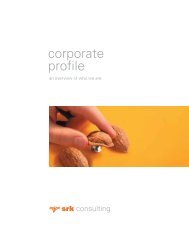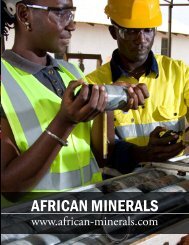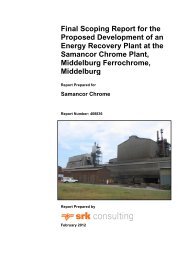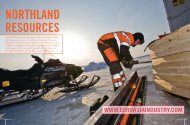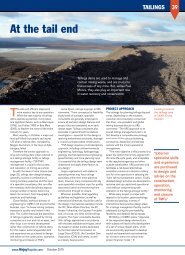Draft Status Quo Report for the Pixley Ka Seme ... - SRK Consulting
Draft Status Quo Report for the Pixley Ka Seme ... - SRK Consulting
Draft Status Quo Report for the Pixley Ka Seme ... - SRK Consulting
You also want an ePaper? Increase the reach of your titles
YUMPU automatically turns print PDFs into web optimized ePapers that Google loves.
<strong>SRK</strong> <strong>Consulting</strong> in association with BKS<br />
<strong>Pixley</strong> <strong>Ka</strong> <strong>Seme</strong> Local Municipality EMF – <strong>Draft</strong> <strong>Status</strong> <strong>Quo</strong> <strong>Report</strong> Page 50<br />
The potential impacts associated with agriculture are<br />
similar to those associated with <strong>for</strong>estry. Impacts<br />
include disturbance caused by <strong>the</strong> clearing of land,<br />
deterioration of soil quality, water quality impacts from<br />
siltation and agricultural wastes; as well as<br />
contamination of surface and groundwater from<br />
fertilizer and pesticide run-off.<br />
Currently environmental impacts associated with<br />
tourism in <strong>the</strong> study area are minor. Limited impacts are<br />
associated with low visitor numbers and unobtrusive<br />
developments as currently managed. As tourism<br />
expands it will need to go hand in hand with increased<br />
management ef<strong>for</strong>t if impacts are to be kept at<br />
acceptable levels. Particular attention will be needed <strong>for</strong><br />
sensitive ecological areas as well as heritage sites.<br />
The consideration of land use changes ideally needs to<br />
take climate change implications into account given <strong>the</strong><br />
importance of <strong>the</strong> ecosystem services that natural<br />
habitats provide in both mitigating and adapting to <strong>the</strong><br />
impacts of climate change. In essence, natural<br />
vegetation is <strong>the</strong> optimum from a GHG emissions<br />
perspective followed by <strong>for</strong>estry (which has potentially<br />
negative biodiversity and water use implications),<br />
agriculture (which can result in relative low emissions if<br />
well managed), and mining (which essentially extracts<br />
concentrated carbon in <strong>the</strong> <strong>for</strong>m of coal from <strong>the</strong> earth<br />
<strong>for</strong> burning and release into <strong>the</strong> atmosphere while also<br />
releasing methane gas embedded in <strong>the</strong> coal seam<br />
which has a global warming potential that is roughly 20<br />
times greater than that of carbon dioxide per volume).<br />
In addition, while management practices have a<br />
significant potential to reduce emissions <strong>for</strong> agriculture,<br />
<strong>the</strong>ir potential in <strong>the</strong> case of coal mining is low given<br />
current technologies.<br />
KILI/BEAT G:\404946_PIXLEY EMF\7REPORTS\<strong>Status</strong> <strong>Quo</strong> report\<strong>Draft</strong> report\<strong>Draft</strong> status quo report, July 2010.docx July 2010



